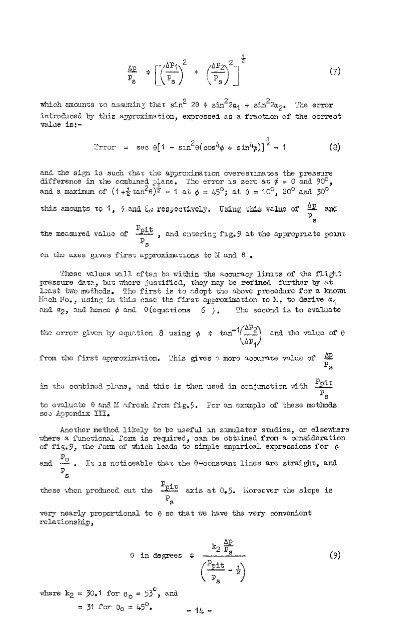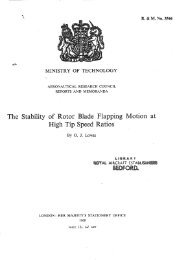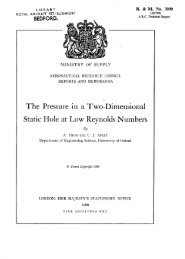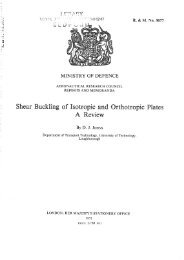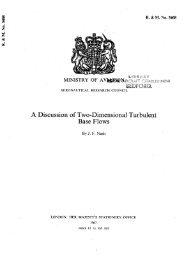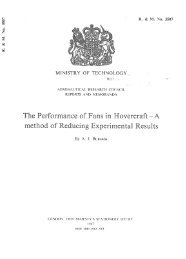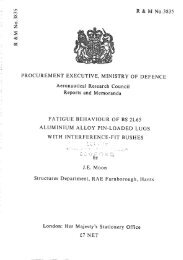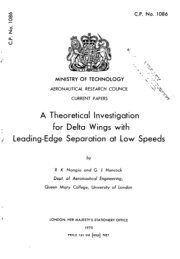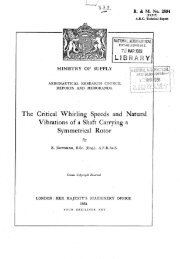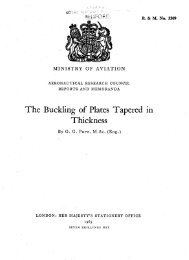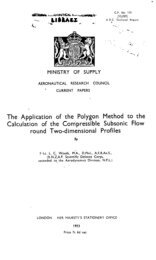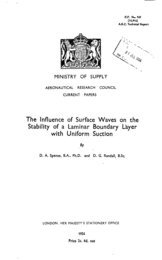Static and Dynamic Response of a Design of Differential ... - aerade
Static and Dynamic Response of a Design of Differential ... - aerade
Static and Dynamic Response of a Design of Differential ... - aerade
You also want an ePaper? Increase the reach of your titles
YUMPU automatically turns print PDFs into web optimized ePapers that Google loves.
which zmounw ?;o assvr;lin~ thzt sin* 28 * sin220~ + sin22a2. 'The error<br />
introticed by this approximation, expressed as a fraction <strong>of</strong> the correct<br />
val~3 is:-<br />
1<br />
2rror = se0 e[1 - s3.n2e(cos4z$ + sin4p)]2 - 1 (8)<br />
<strong>and</strong> ?;he sign is such char; the ap?roximatlon overestwtes the pressure<br />
difference in zhe ccmbrned ;jane. The error 1s sex-c at 6 = 0 <strong>and</strong> YOO,<br />
ana a lil~imum <strong>of</strong> (I+$-tan%)~ - 1 at $ = 450; at 0 = 100, 2o" <strong>and</strong> 300<br />
this sinounts TO I, 3 <strong>and</strong>. C,J res,3ectively. Using &is value <strong>of</strong> h<br />
P<br />
9<br />
<strong>and</strong><br />
the meczzred value <strong>of</strong><br />
*<br />
<strong>and</strong> enterin: f'lg.9 at the appropriate pomp<br />
Ps '<br />
on the axes glvee first approxinztlons to Id <strong>and</strong> 0 .<br />
These values roll &ten be vri'chin the accuracy lirmts <strong>of</strong> the flight<br />
pressure dav., ITUT -d-~re jusr;if'icd, they may be refined further by at<br />
1~cst two methods. The first is to adopt -the above prooetirc for a knov3<br />
Kach PO., using: in this c?.sc the firsT npproxj;nazion to X, to derive a,<br />
<strong>and</strong> "2, 2nd hncc # rind O(equations 6 ) . The second is to evaluate<br />
f&e error given b;? eqw.ti.on 8 using 4 +<br />
from the first a.pproxi.mztion. This ,givcs 1 more accurate wlue <strong>of</strong> 5<br />
9<br />
is tke ocr~bincd ~lanc, __ -Gt this is t&n zscd in conjunction tith $@-<br />
9<br />
to cvo.luate 5 <strong>and</strong> M nfrcsh frcm fig.5. Par an exzmplc <strong>of</strong> these mctltis<br />
SC2 AppcnaJx III.<br />
Another method likely to be useful z.n simulator studies, o? elsewhere<br />
-here a func-iionai form is required, can be obtained from a consideration<br />
<strong>of</strong> fig.5, -the .?orm <strong>of</strong> kich leads to simple empu-ical expressions for p<br />
P<br />
end. 2. IT 1s noticeable that the 8-cons-canr; lines are strsight, <strong>and</strong><br />
pS<br />
These vhen p'oduoed cut The<br />
*<br />
axis at 0.5. I.~oreover zhe slope is<br />
PS<br />
v"r;r nearly proportional to 0 so that ve have the very convenient<br />
relatlonsbip,<br />
8 in degrees e<br />
tiere 112 = 30.1 for 6, f 53', <strong>and</strong><br />
= 31 for e. = 450.<br />
- 14-<br />
AP<br />
k2 g<br />
f- PS ><br />
(7)<br />
(9)


